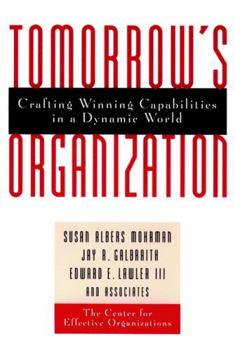Tomorrow's Organization: Crafting Winning Capabilities in a Dynamic World
Select Format
Select Condition 
Book Overview
Create a more flexible, responsive, and competitive business A Publication of The Center for Effective Organizations Picking up where the successful Organizing for the Future left off, this work from the Center for Effective Organizations presents a coherent set of principles and hands-on guidance for creating the successful organization of tomorrow. Celebrated contributors such as Jay Conger, David Finegold, and Tora Bikson--not to mention the editors...
Format:Hardcover
Language:English
ISBN:0787940046
ISBN13:9780787940041
Release Date:February 1998
Publisher:Jossey-Bass
Length:480 Pages
Weight:1.65 lbs.
Dimensions:1.4" x 6.2" x 9.1"
Customer Reviews
2 ratings
The Challenges of the Future.
Published by Thriftbooks.com User , 24 years ago
"Tomorrow's Organization focuses on the new organizational designs and management approaches that are emerging as organizations transform themselves to face the challenges of continuous and relentless global competition. The book is based on two premises. The first is that the nature and intensity of competition have changed, and so organizations are now required to be simultaneously more effective and more flexible in their ability to reconfigure themselves, carry out their dynamic strategies, and make sure they are delivering value to their customers faster and better than their competitors. The second is that strategy and organization are not enough: organizations must also create new approaches to the human issues that accompany change" (from the Preface).In this context, editors divide this invaluable study into four parts:Part I- Designing Competitive Organizations. In this part (Chapters 1-4):* E. E. Lawler III, D. Finegold, and J. A. Conger focus on the development of a framework for understanding the factors that contribute to the effectiveness of corporate boards, and specific principles and practices that can contribute to board effectiveness.* J. R. Galbraith describes customer-product structures, and focuses on three questions concerning this kind of structures: (1). What are hybrid structures? What do they like? (2). Why are companies choosing to organize in this way? (3). How do we make hybrid structures work effectively?* J. R. Galbraith argues that "the new information technology facilitates the networked organization by allowing independent firms to join together in networks". And then he describes the various design issues that have to be addressed in networked organizations.* J. R. Galbraith examines the factors on which companies organize their global operations, and considers the major approaches to organizing, as well as where those approaches fit.Part II- Enabling Competitive Performance. In this part (Chapters 5-7):* D. Finegold, E. E. Lawler III, and G. E. Ledford Jr. ask that 'Is attention to competencies another management fad, or is it a more fundamental and lasting change in the theory and practice of managing organizations and individuals? Then, answering this question, they examine three distinct competency approaches as well as tensions among them. * S. G. Cohen and D. Mankin argue that "New information technologies, combined with the global competitive pressures, have fundamentally changed the nature of work". Then they examine this impact of information technology on the nature of work.* E. E. Lawler III and S. A. Mohrman review employee involvement, total quality management, and reengineering approaches with an eye to assessing both how they unfolded and their long-term implications for the field of management.Part III- Managing People in the Competitive Organizations. In this part (Chapters 8-11):* S. A. Mohrman and E. E. Lawler III outline the specifications of new human
Excellent analysis of the 21st century organization
Published by Thriftbooks.com User , 25 years ago
This book is a comprehensive examination of the changing nature of work and the changing character of the workplace. The text analyzes trends such as reengineering and TQM and whether these trends are likely to continue as is, evolve, or disappear.The role of human resources management is depicted in an expanded role that assumes a cross-functional position in the modern organization. Training is seen as a process of continuous learning rather than a preparation process. Teamwork is shown as an essential facet of technology as projects are too complex to be assigned to individuals. The authors describe an organizational architecture that combines market, social, and technical skills. The individual is described in a nested position within a group, within a business unit, within an organization.This text has been used at Santa Clara University in the Engineering Management and Leadership program and is highly recommended for similar programs or for managers or self-led professionals who want to delve into concepts such as spiral work-flow models and lateral organizations.






